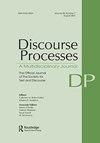Visuospatial Working Memory and Understanding Co-Speech Iconic Gestures: Do Gestures Help to Paint a Mental Picture?
IF 2.1
2区 心理学
Q2 PSYCHOLOGY, EDUCATIONAL
引用次数: 1
Abstract
ABSTRACT Multi-modal discourse comprehension requires speakers to combine information from speech and gestures. To date, little research has addressed the cognitive resources that underlie these processes. Here we used a dual-task paradigm to test the relative importance of verbal and visuospatial working memory in speech-gesture comprehension. Healthy, college-aged participants encoded either a series of digits (verbal load) or a series of dot locations in a grid (visuospatial load) and rehearsed them (secondary memory task) as they performed a (primary) multi-modal discourse comprehension task. Regardless of the secondary task, performance on the discourse comprehension task was better when the speaker’s gestures and speech were congruent than when they were incongruent. However, the congruity advantage was smaller when the concurrent memory task involved a visuospatial load than when it involved a verbal load. Results suggest that taxing the visuospatial working memory system reduced participants’ ability to benefit from the information in congruent iconic gestures. A control experiment demonstrated that results were not an artifact of the difficulty of the visuospatial load task. Overall, these data suggest speakers recruit visuospatial working memory to interpret gestures about concrete visual scenes.视觉空间工作记忆和理解共同语言的标志性手势:手势有助于描绘心理画面吗?
摘要多模态语篇理解要求说话人结合言语和手势信息。到目前为止,很少有研究涉及这些过程背后的认知资源。在这里,我们使用双重任务范式来测试言语和视觉空间工作记忆在言语手势理解中的相对重要性。健康的大学年龄参与者对一系列数字(言语负荷)或网格中的一系列点位置(视觉空间负荷)进行编码,并在执行(主要)多模态话语理解任务时对其进行排练(次要记忆任务)。无论第二项任务如何,当说话人的手势和言语一致时,话语理解任务的表现都要好于不一致时。然而,当并发记忆任务涉及视觉空间负荷时,一致性优势比涉及言语负荷时小。结果表明,对视觉空间工作记忆系统征税会降低参与者从一致的标志性手势中获得信息的能力。对照实验表明,结果并不是视觉空间负荷任务难度的假象。总的来说,这些数据表明,说话者利用视觉空间工作记忆来解释具体视觉场景的手势。
本文章由计算机程序翻译,如有差异,请以英文原文为准。
求助全文
约1分钟内获得全文
求助全文
来源期刊

Discourse Processes
Multiple-
CiteScore
4.30
自引率
4.50%
发文量
27
期刊介绍:
Discourse Processes is a multidisciplinary journal providing a forum for cross-fertilization of ideas from diverse disciplines sharing a common interest in discourse--prose comprehension and recall, dialogue analysis, text grammar construction, computer simulation of natural language, cross-cultural comparisons of communicative competence, or related topics. The problems posed by multisentence contexts and the methods required to investigate them, although not always unique to discourse, are sufficiently distinct so as to require an organized mode of scientific interaction made possible through the journal.
 求助内容:
求助内容: 应助结果提醒方式:
应助结果提醒方式:


